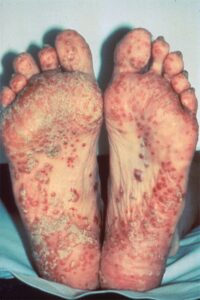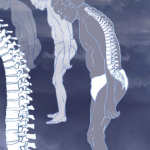In keeping with the features of the spondyloarthopathies, reactive arthritis classically presents with an oligoarthritis, favoring the large joints of the lower extremities. However, polyarticular and small joint involvement is also possible. Dactylitis can be seen in up to 40% of patients, and enthesitis is common at the plantar fascia and Achilles tendon.17 Axial involvement is more common in patients who are HLA-B27 positive.11 Importantly, unilateral axial involvement without peripheral arthritis is highly atypical and suggestive of infection.18

Figure 2. Numerous pustules are present on the feet of a patient with reactive arthritis. They begin as vesicles on erythematous bases and become sterile pustules. On the patient’s right sole, the development of keratotic scales (keratoderma blennorrhagica) is most evident. (Click to enlarge.)
Mucocutaneous manifestations are seen in up to 40% of patients.11 Two characteristic manifestations include keratoderma blenorrhagicum and circinate balanitis. The former is characterized by a hyperkeratotic, psoriasiform rash on the palms and soles (see Figure 2), and the latter features shallow, painless serpinginous ulcerations on the glans penis. Dysuria and penile discharge may also be present. Less specific cutaneous signs include aphthous ulcers and erythema nodusum, both of which can also be seen in inflammatory bowel disease (IBD).
Ocular manifestations include a sterile conjunctivitis in up to 50–75% of patients, as well as anterior uveitis/iritis in 12% of patients.11 Much like in axial spondyloarthritis, uveitis can be a chronic, recurring manifestation warranting long-term immunosuppression.
Cardiac manifestations are less common, and seen in up to 10% of patients. Manifestations include aortitis and aortic insufficiency, conduction abnormalities and pericarditis, particularly in patients with a longer duration of illness.11
There are no specific laboratory tests to confirm the diagnosis. Inflammatory markers, such as erythrocyte sedimentation rate (ESR) and C-reactive protein, are typically elevated, with thrombocytosis and anemia of chronic disease reflecting unchecked inflammation. Exclusion of other rheumatic and infectious diseases is paramount. Gonococcal arthritis, rheumatoid arthritis, spondyloarthropathies (e.g., IBD-associated arthritis and psoriatic arthritis), Lyme disease, viral arthritides, Behçet’s disease and crystalline arthropathies should all be investigated, depending on the patient’s age, history and additional clinical features.
Prognosis
Reactive arthritis is often self-limited, with a good prognosis, resolving over an average of three to five months. About one-third of patients recover fully; however, up to half of patients progress to chronic arthritis.19 Overall, the prognosis of an enteric-induced reactive arthritis seems more favorable than one secondary to infection with Chlamydia.11


